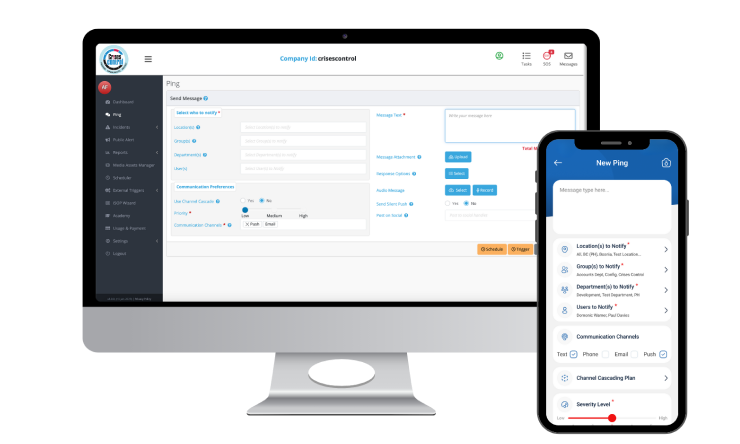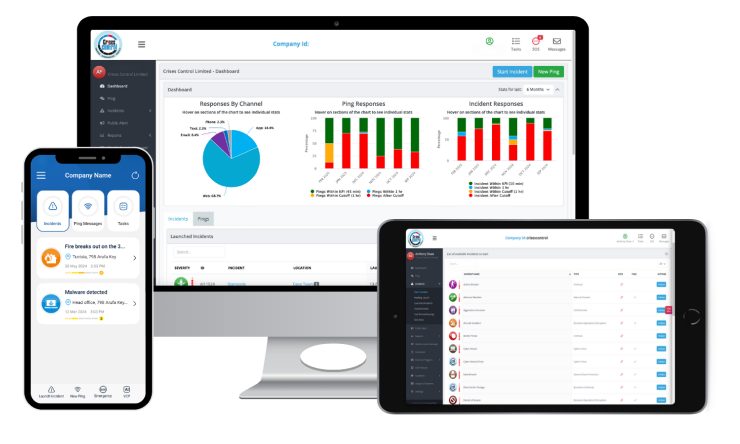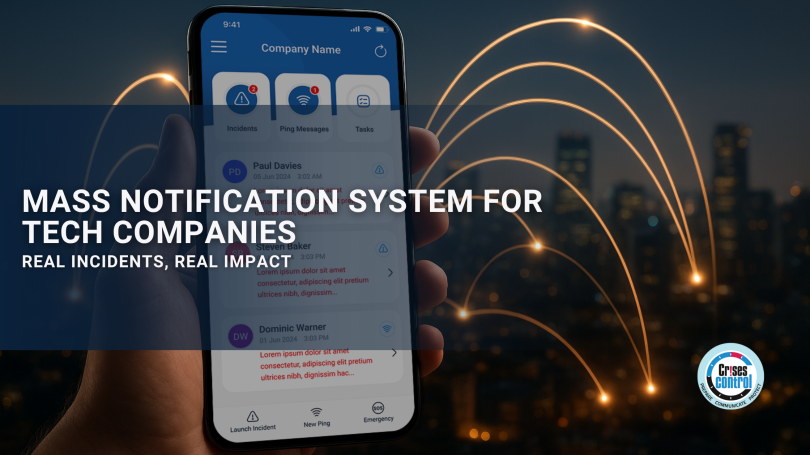Written by Anneri Fourie | Crises Control Executive
Why Tech Companies Need a Mass Notification System
When a major tech outage hits, the clock starts ticking. Services go down. Customers panic. Teams scramble to find out what went wrong. For many technology companies, the biggest problem isn’t just the technical fault itself. It’s the lack of fast, structured communication.
A single hour of downtime can cost a large technology company hundreds of thousands of pounds. Lost revenue is only part of the problem. Delayed responses can lead to frustrated users, regulators asking tough questions, and long-term damage to brand reputation.
A mass notification system solves this communication gap by delivering instant, targeted and verified messages to the right people at the right time. Instead of scattered calls, emails and chat messages, everything happens in one structured and controlled way. This gives teams a clear picture of the situation and allows them to act faster and more effectively.
Real Incidents Where Poor Communication Increased the Impact
Several recent events have shown how outages can escalate quickly when communication breaks down. These incidents are clear reminders of why structured messaging matters.
Optus Emergency Services Outage – September 2025
A firewall upgrade caused a failure in emergency call routing. Communication with emergency services and the public was slow and inconsistent. The incident lasted for hours, led to tragic consequences and left regulators demanding answers. A structured communication process could have ensured faster alerts to critical parties and clearer updates throughout the event.
Starlink Global Outage – July 2025
A service failure disrupted users across continents. Customers learned about the outage through social media long before receiving any official updates. The lack of coordinated communication damaged trust and made recovery harder.
Verizon Network Outage – October 2025
A software issue caused widespread service loss. Messaging to customers and internal teams was delayed and inconsistent. Without a clear way to reach the right teams quickly, the outage dragged on longer than it should have.
In each of these cases, the original issue was technical. What made them worse was how slowly and inconsistently information moved between teams, customers and stakeholders.
How a Mass Notification System Improves Tech Incident Response
A mass notification system for tech companies changes how organisations respond to incidents. Instead of waiting for information to trickle through multiple channels, key updates reach the right people instantly. This improves coordination, speeds up recovery and reduces the fallout from outages.
1. Targeted and Instant Messaging
Not everyone needs the same information during an incident. A mass notification system makes it easy to reach specific teams or regions. This avoids noise and ensures that the people who need to act get the right message quickly.
2. Escalation and Workflow Automation
When alerts depend on manual escalation, delays are common. With automated workflows, if someone doesn’t respond, the alert moves to the next person or team. This keeps response efforts moving without manual follow up.
3. Real-Time Two-Way Communication
Incident management is not just about sending alerts. It’s about knowing what’s happening on the ground. A structured system allows teams to confirm receipt, share updates and provide real-time information. This helps decision-makers act based on facts, not assumptions.
4. Integration with Microsoft Teams
Many tech companies already use Microsoft Teams daily. Crises Control integrates with Teams so alerts can be sent, received and acknowledged inside the same tool people are already working in. This saves time and increases response rates.
5. Reporting and Accountability
A good notification system creates a clear record of what was communicated and when. This is essential for compliance, regulatory reporting and learning from incidents after they’re resolved.
How to Coordinate Teams During Tech Outage Events
When systems go down, teams need more than a chat group or a long email thread. They need a clear way to activate a response, assign responsibilities and communicate updates in real time.
The most effective response plans have these key elements:
- One clear source of truth: Centralising messages prevents conflicting updates and keeps everyone working from the same information.
- Rapid activation: Predefined incident scenarios allow alerts to go out within seconds, not minutes, saving valuable time.
- Clear role assignment: Automated escalation ensures the right people are notified in the right order.
- Consistent stakeholder communication: Internal teams, customers, partners and regulators all receive accurate information without duplication or confusion.
- Post-incident review: Records and reports make it easier to understand what worked and what needs improvement.
This structured approach reduces chaos, speeds up recovery and protects both reputation and revenue.
Real Use Cases from Tech Companies
Some of the most forward-thinking companies in the technology and event sectors are already using Crises Control to support live operations and manage incidents.
One global events and technology company uses the platform to coordinate communication during large-scale live events. Incidents can be launched instantly to notify security, operations and emergency teams. Fire-related incidents, security issues and technical faults are managed through clear, targeted messaging.
The company regularly tests its communication capabilities by sending ping messages and incident alerts. This ensures the system is ready to use at any time. Teams know exactly how to respond when something unexpected happens, which helps keep events running smoothly.
This is a good example of how mass notification software is not just for emergencies. It can be used for planned activities too, strengthening everyday operational readiness.
Benefits of a Mass Notification System for Tech Companies
The advantages of using a structured notification platform are practical and measurable. For tech companies, this means:
- Faster detection and escalation: Alerts are delivered instantly, cutting response times and reducing the length of outages.
- Stronger operational resilience: Teams work with clarity and confidence, even under pressure.
- Easier regulatory compliance: Communication logs and incident records support audits and post-incident reviews.
- Stronger reputation management: Clear, fast updates help maintain trust with users and stakeholders.
- Better employee confidence: Staff know exactly who to contact and what to do during a disruption.
This approach isn’t limited to global corporations. Smaller tech firms can also benefit, especially those with remote or hybrid teams working across different time zones.
Why Crises Control Stands Out
Crises Control is designed to make communication clear, fast and reliable during critical events. The platform goes beyond simple alerts by combining messaging, coordination, escalation and reporting in one place.
Key features include:
- Multi-channel delivery through SMS, voice, email, app push notifications and Microsoft Teams
- Customisable workflows that fit each organisation’s structure and escalation process
- Rapid incident launch using pre-set scenarios
- Detailed reporting for compliance and learning
- Ease of use for both operational and technical teams
This approach turns communication into a strength, not a bottleneck.
Interested in our Ping Mass Notification Software?
Efficiently alert everyone in seconds at scale with our Mass Notification Software.

Prepare Before the Next Outage Happens
Many organisations only improve their communication after a serious incident has already caused damage. Building a structured communication system in advance prevents the same mistakes from repeating.
By having clear messaging, automated escalation and integrated tools, tech companies can stay in control even when services fail.
An outage or security incident does not have to create confusion. With the right tools in place, teams can manage incidents confidently and get back to normal faster.
Take Action Today
Crises Control helps technology companies prepare, communicate and recover with confidence. A single platform brings together mass notification, incident management, escalation and reporting. It gives your teams the clarity they need when it matters most.
If your organisation relies on uptime and rapid response, don’t wait for the next outage to expose communication gaps. Book a free demo and see how Crises Control can help keep your teams connected and in control.
Request a FREE Demo

